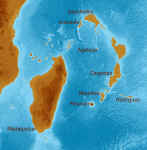|
Geology
The
Seychelles plateau, together with India, Madagascar, Africa, South America and
Antarctica formed Gondwana. 165 million years ago together with Madagascar and
India, Seychelles drifted away from Africa. Leaving Madagascar behind 80 million
years later, and following India to the North, it stopped his voyage 15 million
years later. During this period one
of the greatest volcano eruption events in world’s history had place and
dominated Seychelles and the whole region. The volcanic remains at “Pointe
Zeng Zeng” and “Pointe Ramasse tout” are the only evidence of this
volcanic activity in the earlier Seychelles. Probably there was a crater
south-east of La Passe. The Grand Barbe basin should be a collapsed magma
chamber, seen the difference in composition from the underground. Some theories
also say that the catastrophic impact making an end at the dinosaurs
era should have had place in Seychelles forming the Amirante Bassin, which for
the moment is only half a circle, but at that time Seychelles and India were
still together, so the other half drifted away together with India and should
now lie in front of Bombay.

The Indian Ocean like it was
18000 years ago during the last ice age.
|
Anyway 18.000 years
ago, during the last ice age sea level dropped 120 meters, and the actual
Seychelles were part of a much larger landmass covering +32.000 km˛.
Probably in earlier ice ages sea level was even lower and a land bridge was
formed between the Seychelles, Calgado, Mauritius and Madagascar. This could
explain the presence of some animals like chameleons and day geckos nowadays. The
Seychelles are not just the only granitic mid-ocean islands in the world, they
are also the oldest islands of any ocean.
|
|
